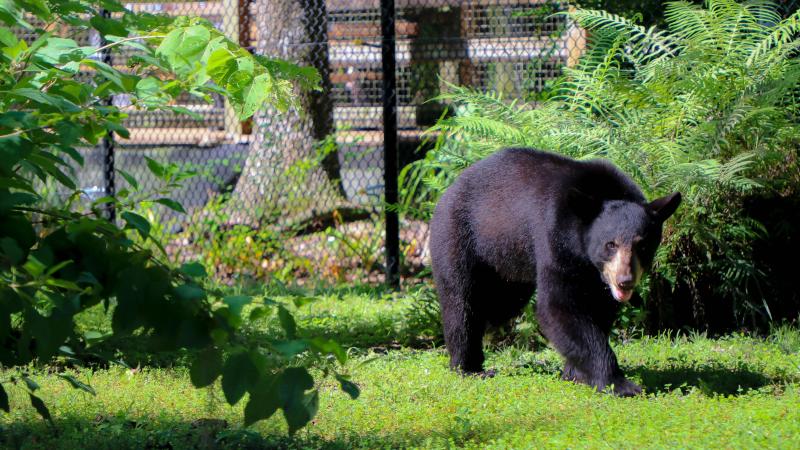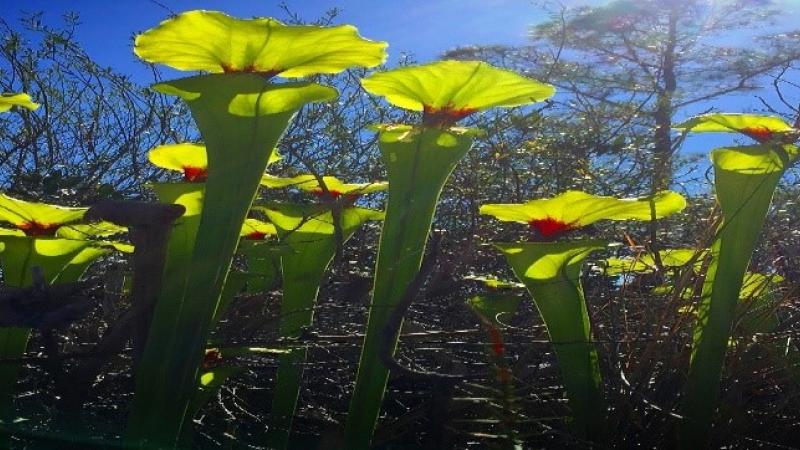Celebrating 50 Years of Prescribed Fire
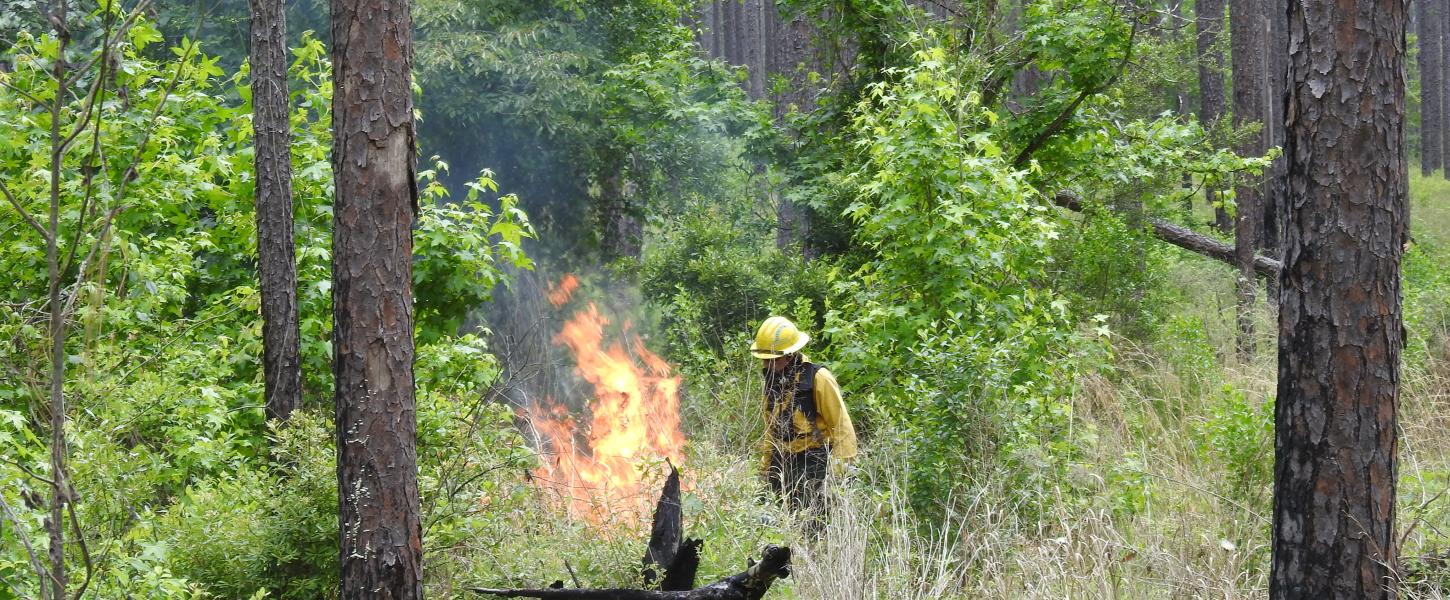
In 1971, the Florida Park Service conducted its first prescribed fire at Falling Waters State Park in Chipley.
Fifty years later, parks director Eric Draper and a group of veteran burners gathered at Falling Waters to conduct a prescribed burn.
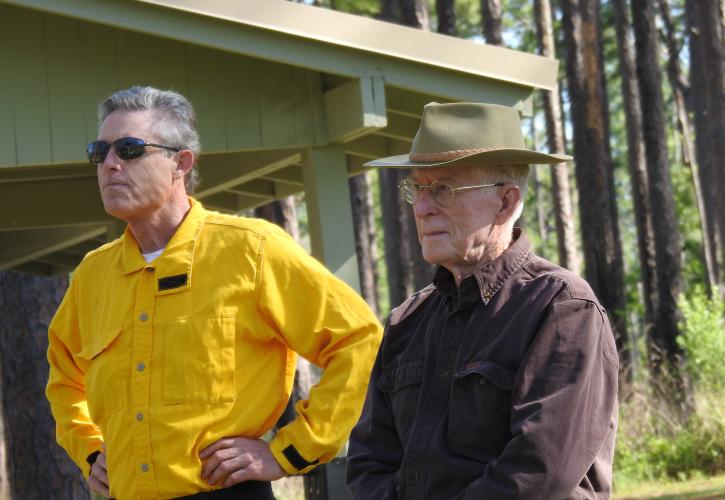
Eric Draper, director of the Florida Park Service, and Jim Stevenson, retired Chief Naturalist, listen while others speak before the commemorative prescribed fire on May 17, 2021, at Falling Waters State Park.

The crew gathers for a photo before the commemorative prescribed fire on May 17, 2021.
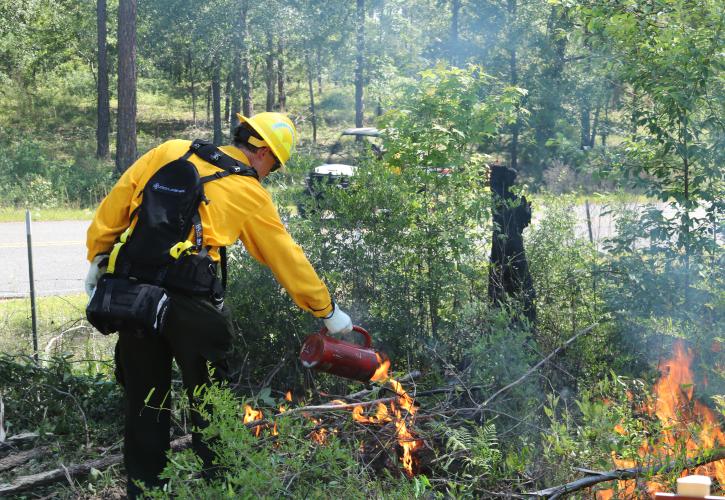
Eric Draper, director of the Florida Park Service, uses a drip torch to start the test fire before the commemorative prescribed fire on May 17, 2021.
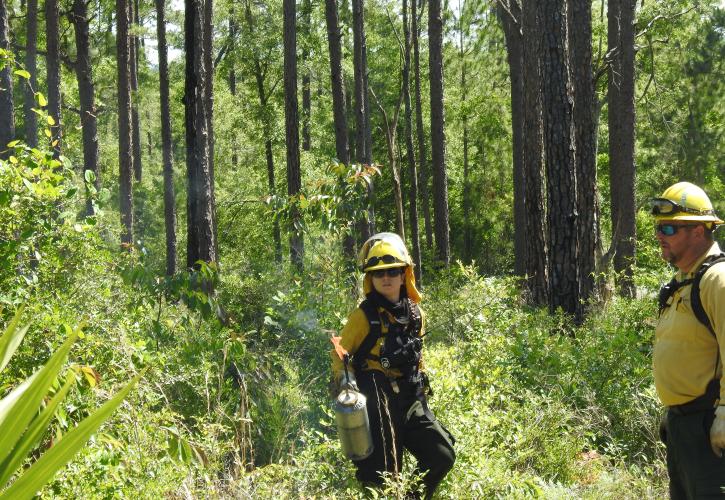
Aimee Wolters holds a drip torch while talking with burn boss, Aaron Miller. Note the uniforms and the safety gear. Yellow Nomex shirts, cotton trousers, leather boots, bright yellow helmets, face shields, goggles, radios for communications, fire shelters and whistles are all standard issue equipment for those working on prescribed fire.
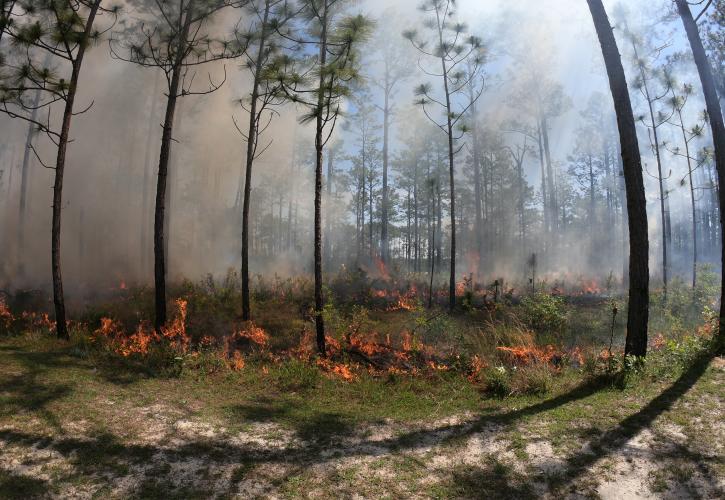
Scene of the commemorative prescribed fire at Falling Waters State Park in 2021.
Much has changed in 50 years
In 1971, the system of state parks consisted of 97 units over 211,182 acres. Today, there are 175 state parks and trails that encompass nearly 800,000 acres. Back then, we didn’t count the number of acres that depended on fire. Now, however, we know that approximately 300,000 acres – a remarkable 42% of the land within Florida’s state parks – need prescribed fire for ecosystems to thrive and to guard against potential wildfires.
The park service’s prescribed fire program has evolved over the years, expanding with and adjusting to new land acquisitions, new training requirements, new personal protective equipment, fire line equipment, uniforms and new safety considerations.
“Our prescribed fire program keeps people and property safe and maintains important wildlife habitat. Credit goes to our well-trained staff and our land management agency partners," said Eric Draper, director of Florida State Parks. "We are also grateful that the Governor and Legislature provide adequate funds for good conservation land management.”
The first prescribed fire in 1971
In 1971, it was not uncommon for some private land holders to regularly conduct prescribed fire. Ed and Betty Komarek owned Birdsong Plantation, a center for conservation and learning in Thomasville, Ga., and Ed worked just a few miles north of Tallahassee at Tall Timbers Research Station. Ed promoted the used of prescribed fire internationally and, along the way, became a friend and mentor to Jim Stevenson, the chief naturalist for Florida’s state parks.
Ed regularly spoke with Jim about the ecological benefits of prescribed fire. Jim convinced his supervisors in Tallahassee to approve the idea of the ecological burn for resource management. They selected Falling Waters State Park because it was easy, simple and safe. The ecosystem was already in pretty good shape with excellent wiregrass.
The crew consisted of Betty Komarek, a professor from California State University, Stevenson, park superintendent (as they were called then) Frank Chesley and two park rangers. Chesley and his rangers were reluctant at first but agreed to participate. Komarek was the only one with experience in prescribed fire, so she served as the first ever burn boss at a Florida state park.
As Stevenson recalled, Komarek gave the orders and the rest of the team followed.
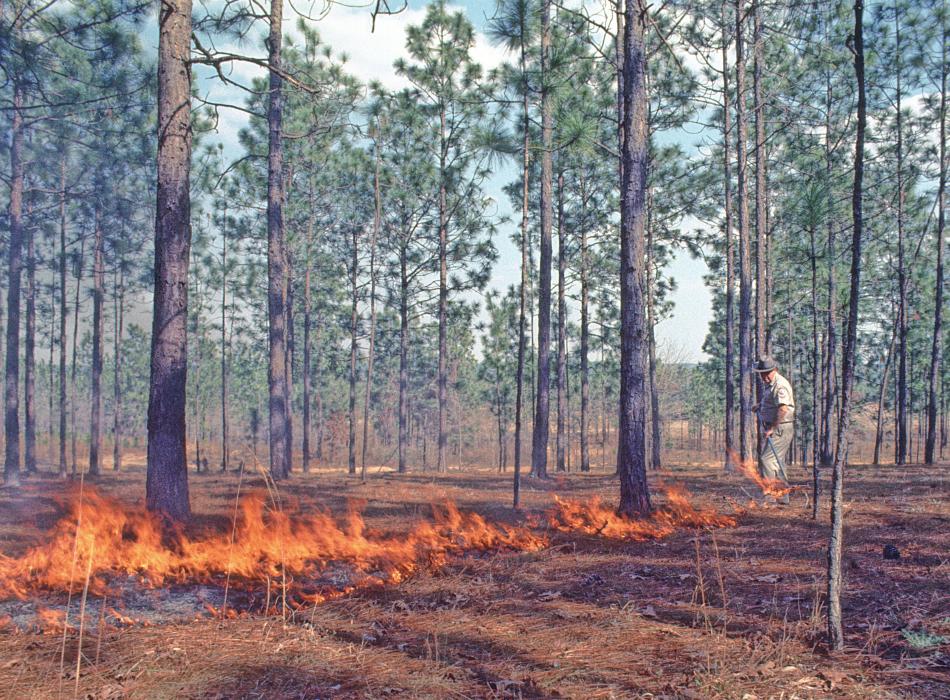
Park superintendent Frank Chesley rakes pine straw during the first official prescribed fire at Falling Waters State Park in 1971.
"Of all the fires that Betty lit in her lifetime to teach others about the ecological importance of fire - at Birdsong, at Tall Timbers, out West and in national parks all around the world - that first Florida State Park burn may have meant the most to her,” writes Kathleen Brady, current executive director at Birdsong Nature Center. “At that time, for a Florida Park leader to place his trust in a woman's expertise and for her to be the one to light that match and lead a team of veteran park service employees who had never burned - much less taken orders from a female fire boss - was remarkable. Betty and Jim were ahead of their time in adopting and teaching the use of prescribed fire."
Winter fires versus growing season fires
Fifty years ago, fire was the enemy.
In 1971, many still abided by Smokey the Bear’s famous slogan “Only You Can Prevent Forest Fires.” The common belief was that all forest fires were undesirable. As a result, park rangers took every measure to suppress wildfire. In 1971, we learned that fire actually benefits the lands we manage.
At that point, we also thought that winter or dormant season fires were best. After years of research and education, park leadership agreed in 1982 that park rangers could conduct burns in the spring, which is the growing season for trees, shrubs and grasses. As this is when most lightning-set fires occur, spring burns mimic nature’s timing and provide tremendous benefits to the plants and animals in the ecosystem.
Today, we plan fires using detailed prescriptions while considering the needs of the ecosystem in conjunction with the weather, the interface with urban areas, and more. We also use prescribed fire to reduce the risks of wildfire by removing the fuels that can feed unintentional ignitions.
Training requirements
In 1971, there was no training for staff members in how to conduct a prescribed fire.
Park rangers today undergo at least 40 hours of training and must pass a physical work capacity exercise test known as the pack test. Out in the field, the fire person must carry 25 pounds at a fast walking pace for 2 miles in 30 minutes or less. They also participate in a closely supervised trainee role before they can fully participate in a prescribed fire as a fire crew member.
In 2020, the Florida Park Service developed additional virtual opportunities for training staff in the classroom portions of fire trainings. Practical application must still be learned in the field.
Staff members are encouraged to find a mentor.
Equipment
The first fire tools were primitive. The crew had flaps, rakes and a drip torch. Sometimes they didn’t even have a brush truck, which carries equipment for fire crews.
Over time, trucks were purchased and retrofitted with fire gear and water tanks.
Over the last five years, the Florida Park Service has focused resources to update one-third of the fleet of wildland fire engines used in the prescribed fire program. Since 2017, the division has replaced 27 fire engines with custom equipment designed for supporting prescribed fire in Florida’s natural communities.
The average age of the surplus equipment was more than 20 years, with some greater than 30 years old. The fleet still has 24 fire engines that were purchased before 2000. Having safe, modern, dependable trucks to support fire management activities is a top priority for the Florida Park Service.
“One big change is the design of the fire engines used by fire managers,” said Sasha Ernst, the statewide fire coordinator for Florida State Parks. “Over the last 25 years, designs have been modified and improved with feedback from field staff. Today, the Florida Park Service runs some of the best trucks out on the fire lines because of cooperating and collaboration used in created them.”
All equipment and trained Florida Park Service fire staff in the prescribed fire program are also on stand-by to respond to the threat of wildland fire on state park property and on private and partner lands.
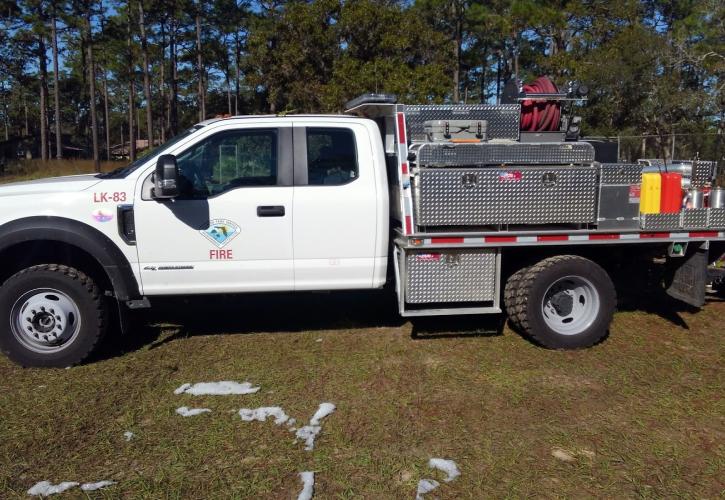
Example of a fire truck.
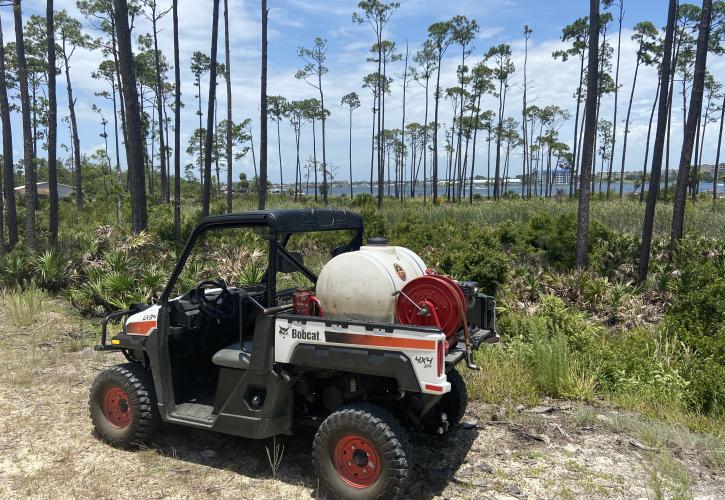
Example of a UTV with a water tank used for managing fire.
Uniforms
At that first fire at Falling Waters State Park, crews wore their cotton work uniforms. The uniforms were in short supply, so they sometimes switched to denim.
Sandy Cook Apthorp was a park ranger in 1977 at Mike Roess Gold Head Branch State Park. She remembers when the uniforms shirts changed to a green cotton-polyester. The trousers were polyester, which can melt and catch fire easily. In that era, park rangers sometimes had burn holes in their uniforms. It was common for rangers to wear blue jeans and cotton T-shirts to save their uniforms.
Rosi Mulholland started her career as a district biologist in 1984. She remembers her first fire uniform was flame-resistant Nomex pants and shirt, web gear for a canteen (not for a fire shelter initially), leather gloves, her own leather boots and a hard hat with a face shield.
Miranda Cunningham started as a park ranger at Jonathan Dickinson State Park in 2001. She says, “My first fire uniform was the dreaded banana suit/fire-onesie with pants and a T-shirt underneath, my sister’s old Army boots, a helmet, military web gear and gloves.”
Today's uniform emphasizes safety and preparedness. Anyone working on prescribed fire, wildfire or mop-up activities must wear all the required gear, including:
- Nomex pants, shirt or jumpsuit.
- Leather gloves and boots.
- Nomex neck, ear and face protector attached to a yellow hardhat with green reflective stickers.
- Eye protection (face shield, goggles, safety-rated glasses).
- Ear protection is required for working around pump engines, chainsaws or heavy equipment.
- Bandana for filtering large particulates while working in heavy smoke.
Each staff member working on a fire must carry a fire shelter, directional compass, hand-held radio in a chest pack, headlamp or flashlight, whistle, and means for starting a fire, such as matches.
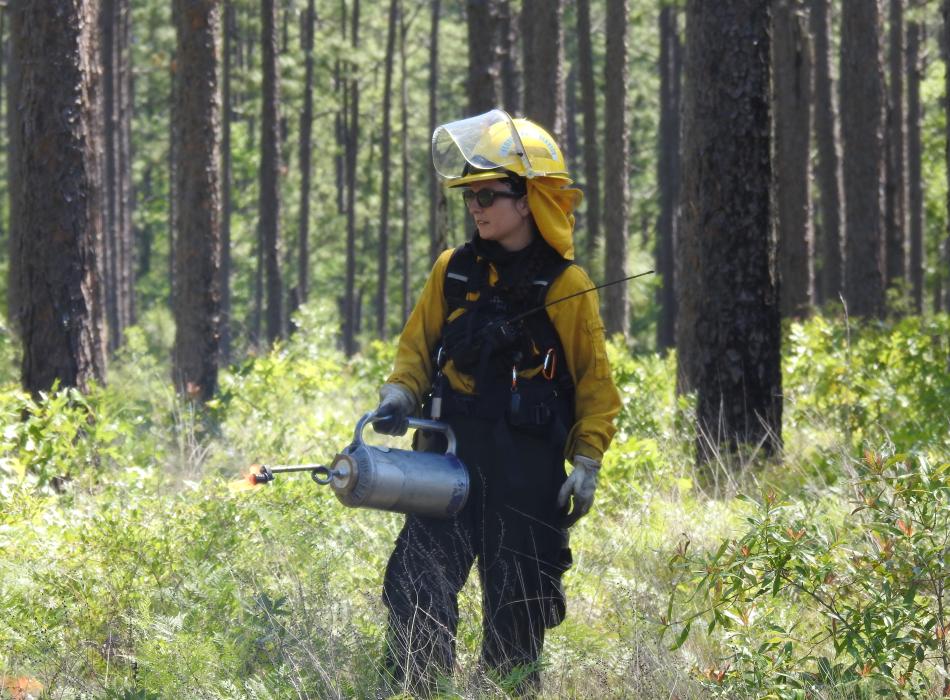
A crew member wearing appropriate personal protective equipment.
Partner Expertise
As the fire program developed, the team added more acreage as they identified those with appropriate ecosystems. Originally, staff at each participating park implemented fire. As the program grew, they started sharing resources and staff.
One thing that hasn’t changed over the last 50 years is the value placed on partnerships with other organizations and state agencies.
That first prescribed fire, back in 1971, came about because Ed Komarek of Tall Timbers Research Station convinced Jim Stevenson to seek permission for it. Tall Timbers has been a constant partner ever since.
“We congratulate Florida State Parks for not only being an early adopter of prescribed fire but for what they have accomplished in the past 50 years to expand the use of prescribed fire,” said Dr. William Palmer, president and CEO of Tall Timbers. “Park guests from around the world get to experience the fascinating beauty of well-managed fire-adapted landscapes. By sharing the story of prescribed fire as a positive part of nature with guests, Florida State Parks is helping shape a future with less wildfires and better habitat for wildlife.”
Of course, the Florida Forest Service, which is part of the Florida Department of Agriculture and Consumer Services, has also been a valuable partner.
In March 2021, the Florida Park Service conducted the largest fire in its history at Kissimmee Prairie Preserve State Park. A crew of 34 burned 11,533 acres in one day. Partners included the St. Johns Water Management District, Flagler County and The Nature Conservancy. Staff contracted to employ a helicopter, which was used to drop plastic ignition spheres across the zone. The spheres ignite on a 30-second time delay. Crew members managed the fire from the ground, while burn boss Chris Camargo was able to monitor the fire from the helicopter and relay information to the crew via radio.
The Future is Bright
In 2007, the Florida Park Service celebrated the milestone of 1 million acres burned.
On June 8, 2021, the Florida Park Service reached the 2-million-acre mark.
For perspective, that’s a 36-year span trimmed down to just 14.
In 2021, the Florida Park Service entered into an aerial fire support services contract with multiple helicopter companies to include use of aerial support across the state.
Park staff and fire managers constantly look for improvements and efficiencies to make prescribed fire even more effective while still ensuring safety.
How Can You Help?
Florida State Parks Foundation Plant a Pine initiative
On Earth Day, April 22, 2020, the Florida State Parks Foundation announced a goal of planting 100,000 longleaf pine trees by Earth Day 2021. Florida’s longleaf forests have declined by more than 80% over the past century. For every $1 donated, the foundation plants one longleaf pine seedling in a Florida State Park.
On May 13, 2021, the foundation announced that it had hit the goal of planting 100,000 longleaf pines. Now, they have launched a campaign to plant another 100,000 trees.
You can contribute to the foundation’s efforts by donating to the Plant a Pine project.
Web Resources/About Good Fires
Fires play a vital role in maintaining certain ecosystems. Acres maintained by prescribed fire provide improved forage and habitat for wildlife, and the severity of wildfires is reduced.
- What is prescribed fire?
- Steps of a prescribed fire
- Seven animals that rely on prescribed fire
- Good Fires - Prescribed Fire in the South
This article was published in the Real Florida ℠ Connection, the Florida State Parks e-newsletter. Sign-up to get updates and stories from your state parks the first week of every month.
